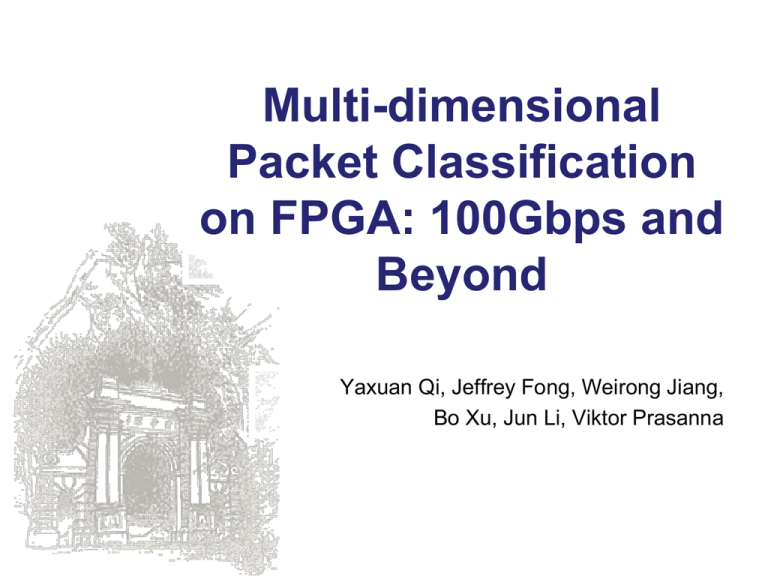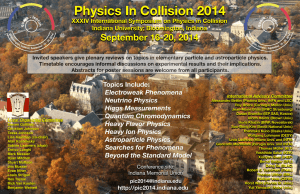FPGA-HyperSplit
advertisement

Multi-dimensional Packet Classification on FPGA: 100Gbps and Beyond Yaxuan Qi, Jeffrey Fong, Weirong Jiang, Bo Xu, Jun Li, Viktor Prasanna Outline • • • • Background and Motivation • The packet classification problem • Existing solutions & Challenges Algorithm and Architecture Design • HyperSplit • Mapping into hardware & Optimizations Performance Evaluation • Test Setup • Experimental Results Conclusion NSLab, RIIT, Tsinghua Univ Outline • • • • Background and Motivation • The packet classification problem • Existing solutions & Challenges Algorithm and Architecture Design • HyperSplit • Mapping into hardware & Optimizations Performance Evaluation • Test Setup • Experimental Results Conclusion NSLab, RIIT, Tsinghua Univ Packet Classification Problem To identify and associate each packet to a specific rule May match multiple rules Used for: Routing Firewall/ Intrusion Detection System Quality of Service NSLab, RIIT, Tsinghua Univ Existing Solutions SRAM Based Software running on general hardware Different algorithms gives different search speed and/or number of rules Advantage: Speed Different hardware architecture gives different speed Advantage Speed Disadvantage Price (generally) # of Rules Disadvantage TCAM Based Dedicated packet matching hardware Price Energy consumption Chip size No support for Range NSLab, RIIT, Tsinghua Univ Range to Prefix Conversion Existing Solutions Search Method Algorithms RFC Decomposition HSM SRAM based Methods HiCut Decision Tree HyperSplit NSLab, RIIT, Tsinghua Univ Existing Solutions Search Method Algorithms RFC Decomposition HSM SRAM based Methods HiCut Decision Tree HyperSplit NSLab, RIIT, Tsinghua Univ Challenges & Goals • Memory Usage • • High Performance • • Needs to be memory efficient that can support large rulesets Requires high throughput and deterministic performance On-the-fly update • To allow rules to be changed and updated without downtime NSLab, RIIT, Tsinghua Univ Outline • • • • Background and Motivation • The packet classification problem • Existing solutions & Challenges Algorithm and Architecture Design • HyperSplit • Mapping into hardware & Optimizations Performance Evaluation • Test Setup • Experimental Results Conclusion NSLab, RIIT, Tsinghua Univ HyperSplit • Memory-efficient packet classification algorithm • • • • Uses 1/10 (10%) of the memory that other comparable algorithms requires Optimized k-d tree data structure Combines the advantages of both parallel search and tree search algorithms Uses heuristics to select the most efficient splitting point on a specific field NSLab, RIIT, Tsinghua Univ Example 11 R4 10 R2 R3 01 00 R5 R1(R2) 00 NSLab, RIIT, Tsinghua Univ 01 10 11 Example 11 X,01 X<=01 L Lv-1 X>01 R R4 10 R2 R3 01 R5 R1 00 00 NSLab, RIIT, Tsinghua Univ 01 10 11 Example 11 X,01 X<=01 Y,00 Y<=00 R1 X>01 R Y>00 R2 Lv-1 R4 10 R2 R3 01 Lv-2 00 R5 R1 00 NSLab, RIIT, Tsinghua Univ 01 10 11 Example Lv-1 Lv-2 11 X,01 X<=01 X>01 Y,00 Y<=00 R1 10 X,10 Y>00 X<=10 R2 R3 R4 X>10 RR R2 R3 01 Lv-2 00 R5 R1 00 NSLab, RIIT, Tsinghua Univ 01 10 11 Example Lv-1 Lv-2 11 X,01 X<=01 Lv-3 X>01 Y,00 Y<=00 R1 R4 10 X<=10 R2 R3 X>10 R5 R5 R1 00 Y,10 Y<=10 R3 01 Lv-2 00 X,10 Y>00 R2 Y>10 R4 NSLab, RIIT, Tsinghua Univ 01 10 11 Mapping Decision into Hardware X,01 Y,00 R1 X,10 R2 R3 Y,10 R5 NSLab, RIIT, Tsinghua Univ R4 Mapping Decision into Hardware X,01 Y,00 R1 X,10 R2 R3 Y,10 R5 NSLab, RIIT, Tsinghua Univ R4 Mapping Decision into Hardware INPUT PACKET STAGE 1 X,01 Y,00 R1 STAGE 2 X,10 R2 R3 STAGE 3 Y,10 R5 R4 STAGE 4 MATCHED RULE NSLab, RIIT, Tsinghua Univ Hardware Implementation STAGE n NSLab, RIIT, Tsinghua Univ Architecture Optimization (1) Node Merging – Pipeline Depth Reduction @addr0 d1,v1 addr1 @addr1 d1,v1 addr2 @addr2 @addr2+1 child1 child2 @addr0 d1,d2,d3 v1,v2,v3 addr1 @addr1+1 d1,v1 addr3 @addr3 @addr3+1 child1 child2 @addr1 @addr1+1 @addr1+2 @addr1+3 child1 child2 child3 child4 NSLab, RIIT, Tsinghua Univ Architecture Optimization (2) Controlled Block RAM Allocation - Different rulesets will result in different memory usage per stage - Limits the size of a certain stage by pushing leafs to lower levels of the pipeline NSLab, RIIT, Tsinghua Univ Architecture Optimization (3) Dual-search pipeline • take advantage of dual-port BRAM NSLab, RIIT, Tsinghua Univ Outline • • • • Background and Motivation • The packet classification problem • Existing solutions & Challenges Algorithm and Architecture Design • HyperSplit • Mapping into hardware & Optimizations Performance Evaluation • Test Setup • Experimental Results Conclusion NSLab, RIIT, Tsinghua Univ Test Setup • Tested with a publicly available ruleset from Washington University • • Used the ACL 100, 1K, 5K, 10K rulesets Design is implemented on a Xilinx Virtex-6 • • • Model: VC6VSX475T Containing 7,640Kb Distributed RAM and 38,304Kb Block RAM Using Xilinx ISE 11.5 tool NSLab, RIIT, Tsinghua Univ Algorithm Evaluation Node-merging Optimization Reduce tree height (pipeline depth) by almost 50% with minimal memory overhead! NSLab, RIIT, Tsinghua Univ Algorithm Evaluation Leaf-pushing Optimization NSLab, RIIT, Tsinghua Univ FPGA Performance NSLab, RIIT, Tsinghua Univ FPGA Performance NSLab, RIIT, Tsinghua Univ Outline • • • • Background and Motivation • The packet classification problem • Existing solutions & Challenges Algorithm and Architecture Design • HyperSplit • Mapping into hardware & Optimizations Performance Evaluation • Test Setup • Experimental Results Conclusion NSLab, RIIT, Tsinghua Univ Conclusion • FPGA provides a flexible and excellent solution to the packet classification problem • HyperSplit algorithm is suited to and provides an efficient mapping to hardware • 3 optimizations used to reduce tree length, constraint the memory usage of each stage and improve performance • Consume less resource than other FPGA-based solutions and much faster than multicore based solutions NSLab, RIIT, Tsinghua Univ







